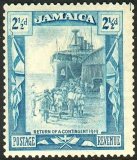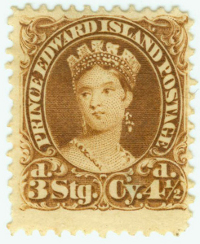
Discussion - Member to Member Sales - Research Center

Discussion - Member to Member Sales - Research Center

Can you help me identify this perf 10V coil stamp? The second photo is the stamp with Ronsonol on it (looking for a watermark). Thanks in advance for your patience and assistance as I slowly (glacially) improve my identifying skills.
Ben

Login to Like
this post
I'm guessing Scott # 492 but I'm wrong a majority of the time

Login to Like
this post
I agree with pedroguy:
1. Type III design (ribbons,lips,toga rope).
2. Perfed 10 vertically.
3. Apparently no watermark.
4. Flat Plate printing.
Couple things on determining perfs and press type off screen images:
- you can count perfs along side, top, or both, and compare count to known stamps in your collection.
- I recently made a "rotary press calculator" in Excel. It works off the ratio of design width to design height. You simply lay a ruler on your computer screen and drop the dimensions into the calculator. That ratio for rotary press printings will be either less than 1.13 or greater than 1.21. Flat plate printings will be somewhere in between. Yours stamp calculated at about 1.15 for me. CAUTION: image you measure must be flat and not skewed. This calculator is very useful for making press determinations off images posted on eBay, for example. Many sellers have inaccurate descriptions, and I look to exploit that if possible.

2 Members
like this post.
Login to Like.
I agree with pedroguy, a Scott #492
- 10V perf
- rotary press stamp (can tell by color, printing, and lack of any setoff on back of stamp which would make it a flat plate printing)
- no watermark
This means it would have to be either a Scott 491 (Type II) or 492 (Type III).
A bit hard to tell with the low resolution image but appears to be a Type III (Scott #492), the left ribbon has two lines of shading.
Additional info
http://www.stampsmarter.com/1847usa/washfrank/d32p10coil.html
http://www.stampsmarter.com/1847usa/washfrank/2cT01_03main.html
This link is one of the quickest ways (3 steps) to ID these pesky W/F stamps...
http://www.stampsmarter.com/features/SQL_Wash_Frank_ID.html
Most experts do not recommend trying to hand measure designs, it is one of the least reliable ways to ID a rotary press stamp. Aside from being very difficult to measure it, the dimensions given by most sources are rounded off estimates. The margin of error in measuring and the dimensions is simply too large to be used properly.
A better approach is to use a template made from known stamps as shown here
http://stampsmarter.com/learning/Manuf_printingmethods.html
Don

2 Members
like this post.
Login to Like.
Stude,
I agree that it is dangerous to try to directly measure designs to determine press type.
But if you cannot have access to the actual stamp in question, you have no other choice (as in trying to determine if an eBay seller's description is accurate).
I agree that there is a lot of potential inaccuracy in measuring stamp designs. It's about impossible to do it repeatably off the actual stamp. The nice thing about measuring off a computer screen is that you can reduce the measurement error by blowing up the image in your viewer. Looking at a ratio of width to height means it doesn't matter what the actual measurements are, it's the relative measurements you're after. And, you don't need a super-high resolution image to get a repeatable result. That said, there are a lot of images that are badly skewed or otherwise distorted that are useless for this technique.
I appreciate your insight!

Login to Like
this post
Hi pigdoc,
My thinking is that these posts are typically read by casual collectors. Folks who do not want a degree in stamp production or postal history but would like to ID their stamps quickly and efficiently. This is probably why ‘measuring’ is attractive to many; they think it is an easy, definitive way to ID a US W/F rotary press stamp.
My opinion is that making some simple templates from existing, known stamp (as shown in link above) is by far the quickest way to do this. If folks have enough W/F stamps, making a few templates and spending a few hours with them and they will learn how to ID rotary stamp just by the look and feel. But I have seriously considered removing all design dimensions from Stamp Smarter due to the prevalence of folks who try to use them to ID W/F stamps (but have left them for completeness).
Your method IDs images, not stamps…in this digital age, this can be an important capability. I think you are correct that a ratio based upon relative measurements could be quite useful. But as you note, this is another layer of complexity and introduces another possibility of error. Camera images would absolutely not work well since the camera angle would have to be exactly 90 degree over the stamp (possible but not likely for most hobbyists). Scans should work but this depends upon the scanner and the ‘scanee’ (user). For example, scanning a stamp located at the edges of the platen can introduce skew and distortion since the CCD (sitting in the middle of the bar) uses a lens (think fisheye) to reach the entire scanning region. Of course an image of the back of the stamp (and any possible setoff) is another ‘image based’ method which can be highly helpful.
If a person is interested in specializing in W/F’s and was actively buying these stamps online, then using your method would be helpful in spotting misidentified stamps. Of course, make sure that the seller return policy allowed return for those images which might mislead you.
Don
APS #094826

Login to Like
this post
09:29:23am
Hello friends,
Can you help me identify this perf 10V coil stamp? The second photo is the stamp with Ronsonol on it (looking for a watermark). Thanks in advance for your patience and assistance as I slowly (glacially) improve my identifying skills.
Ben

Login to Like
this post

re: Help identifying this 2 cent coil stamp
I'm guessing Scott # 492 but I'm wrong a majority of the time

Login to Like
this post
10:56:41am
re: Help identifying this 2 cent coil stamp
I agree with pedroguy:
1. Type III design (ribbons,lips,toga rope).
2. Perfed 10 vertically.
3. Apparently no watermark.
4. Flat Plate printing.
Couple things on determining perfs and press type off screen images:
- you can count perfs along side, top, or both, and compare count to known stamps in your collection.
- I recently made a "rotary press calculator" in Excel. It works off the ratio of design width to design height. You simply lay a ruler on your computer screen and drop the dimensions into the calculator. That ratio for rotary press printings will be either less than 1.13 or greater than 1.21. Flat plate printings will be somewhere in between. Yours stamp calculated at about 1.15 for me. CAUTION: image you measure must be flat and not skewed. This calculator is very useful for making press determinations off images posted on eBay, for example. Many sellers have inaccurate descriptions, and I look to exploit that if possible.

2 Members
like this post.
Login to Like.

re: Help identifying this 2 cent coil stamp
I agree with pedroguy, a Scott #492
- 10V perf
- rotary press stamp (can tell by color, printing, and lack of any setoff on back of stamp which would make it a flat plate printing)
- no watermark
This means it would have to be either a Scott 491 (Type II) or 492 (Type III).
A bit hard to tell with the low resolution image but appears to be a Type III (Scott #492), the left ribbon has two lines of shading.
Additional info
http://www.stampsmarter.com/1847usa/washfrank/d32p10coil.html
http://www.stampsmarter.com/1847usa/washfrank/2cT01_03main.html
This link is one of the quickest ways (3 steps) to ID these pesky W/F stamps...
http://www.stampsmarter.com/features/SQL_Wash_Frank_ID.html
Most experts do not recommend trying to hand measure designs, it is one of the least reliable ways to ID a rotary press stamp. Aside from being very difficult to measure it, the dimensions given by most sources are rounded off estimates. The margin of error in measuring and the dimensions is simply too large to be used properly.
A better approach is to use a template made from known stamps as shown here
http://stampsmarter.com/learning/Manuf_printingmethods.html
Don

2 Members
like this post.
Login to Like.
11:41:33am
re: Help identifying this 2 cent coil stamp
Stude,
I agree that it is dangerous to try to directly measure designs to determine press type.
But if you cannot have access to the actual stamp in question, you have no other choice (as in trying to determine if an eBay seller's description is accurate).
I agree that there is a lot of potential inaccuracy in measuring stamp designs. It's about impossible to do it repeatably off the actual stamp. The nice thing about measuring off a computer screen is that you can reduce the measurement error by blowing up the image in your viewer. Looking at a ratio of width to height means it doesn't matter what the actual measurements are, it's the relative measurements you're after. And, you don't need a super-high resolution image to get a repeatable result. That said, there are a lot of images that are badly skewed or otherwise distorted that are useless for this technique.
I appreciate your insight!

Login to Like
this post

re: Help identifying this 2 cent coil stamp
Hi pigdoc,
My thinking is that these posts are typically read by casual collectors. Folks who do not want a degree in stamp production or postal history but would like to ID their stamps quickly and efficiently. This is probably why ‘measuring’ is attractive to many; they think it is an easy, definitive way to ID a US W/F rotary press stamp.
My opinion is that making some simple templates from existing, known stamp (as shown in link above) is by far the quickest way to do this. If folks have enough W/F stamps, making a few templates and spending a few hours with them and they will learn how to ID rotary stamp just by the look and feel. But I have seriously considered removing all design dimensions from Stamp Smarter due to the prevalence of folks who try to use them to ID W/F stamps (but have left them for completeness).
Your method IDs images, not stamps…in this digital age, this can be an important capability. I think you are correct that a ratio based upon relative measurements could be quite useful. But as you note, this is another layer of complexity and introduces another possibility of error. Camera images would absolutely not work well since the camera angle would have to be exactly 90 degree over the stamp (possible but not likely for most hobbyists). Scans should work but this depends upon the scanner and the ‘scanee’ (user). For example, scanning a stamp located at the edges of the platen can introduce skew and distortion since the CCD (sitting in the middle of the bar) uses a lens (think fisheye) to reach the entire scanning region. Of course an image of the back of the stamp (and any possible setoff) is another ‘image based’ method which can be highly helpful.
If a person is interested in specializing in W/F’s and was actively buying these stamps online, then using your method would be helpful in spotting misidentified stamps. Of course, make sure that the seller return policy allowed return for those images which might mislead you.
Don
APS #094826

Login to Like
this post

